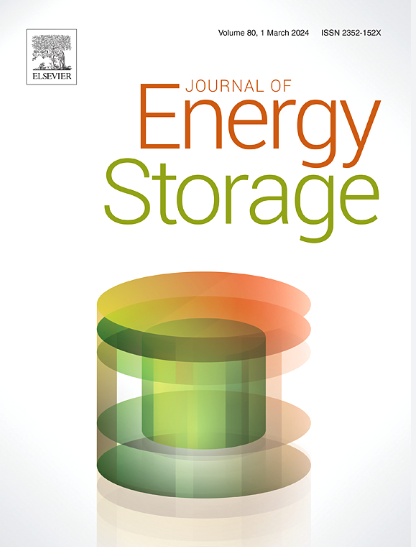电化学储锂用高熵金属硫化物fenicoclix的合成
IF 8.9
2区 工程技术
Q1 ENERGY & FUELS
引用次数: 0
摘要
各种金属硫化物以其高比容量的特点作为锂离子电池的负极得到了广泛的研究。然而,它们的低转化反应可逆性和在充放电循环中重复的体积膨胀/收缩导致倍率能力差,容量衰减快。高熵硫化物作为一种新型的可充电电池电极材料,由于其优异的电化学性能而备受关注。本文介绍了甘油模板法合成高熵硫化物fenicocilisx的两步溶剂热法。在重复锂化/去锂化过程中,不同金属阳离子的均匀分散和混合不仅可以有效抑制金属纳米团簇的聚集和Li2S的粗化,还可以保持金属纳米团簇与Li2S之间有效的界面接触,从而显著提高转化反应的可逆性和循环稳定性。因此,FeNiCoCuLiSx由于其大的构型熵和多组分“鸡尾酒效应”,在可逆锂存储方面表现出优异的电化学性能。FeNiCoCuLiSx在1.0 a g−1电流密度下可提供高达860 mAh g−1的可逆比容量,在5.0 a g−1电流密度下可提供775 mAh g−1的高倍率容量。经过1600次循环,在1.0 a g−1电流密度下,可逆比容量保持在826 mAh g−1,容量保持率为95.5%,表现出良好的长周期稳定性能。本文章由计算机程序翻译,如有差异,请以英文原文为准。

Synthesis of high-entropy metal sulfide FeNiCoCuLiSx for electrochemical lithium storage
Various metal sulfides have been widely investigated as anodes of Li-ion batteries their high specific capacity. However, their low conversion reaction reversibility and repeat volume expansion/contraction during charge-discharge cycling result in poor rate capability and rapid capacity decay. High-entropy sulfides have attracted great attention as novel electrode materials for rechargeable batteries due to their excellent electrochemical performance. This work presented a two-step solvothermal process to synthesis high-entropy sulfide FeNiCoCuLiSx by means of the glycerol template method. During repeat lithiation/delithiation, the homogeneous dispersion and mixing of the different metal cations could not only effectively suppress the aggregation of metal nanoclusters and coarseness of Li2S, but also maintain valid interfacial contact between the metal nanoclusters and Li2S, resulting in significantly improved the conversion reaction reversibility and more cyclic stability. Therefore, FeNiCoCuLiSx exhibited excellent electrochemical performance for reversible lithium storage, due to its large configurational entropy and multi-component “cocktail effect”. FeNiCoCuLiSx could deliver a reversible specific capacity as high as 860 mAh g−1 at the current density of 1.0 A g−1 and a high-rate capability of 775 mAh g−1 at 5.0 A g−1. After 1600 cycles, the reversible specific capacity of 826 mAh g−1 remained with a capacity retention of 95.5 % at the current density of 1.0 A g−1, well demonstrating excellent long-cycle stable performance.
求助全文
通过发布文献求助,成功后即可免费获取论文全文。
去求助
来源期刊

Journal of energy storage
Energy-Renewable Energy, Sustainability and the Environment
CiteScore
11.80
自引率
24.50%
发文量
2262
审稿时长
69 days
期刊介绍:
Journal of energy storage focusses on all aspects of energy storage, in particular systems integration, electric grid integration, modelling and analysis, novel energy storage technologies, sizing and management strategies, business models for operation of storage systems and energy storage developments worldwide.
 求助内容:
求助内容: 应助结果提醒方式:
应助结果提醒方式:


